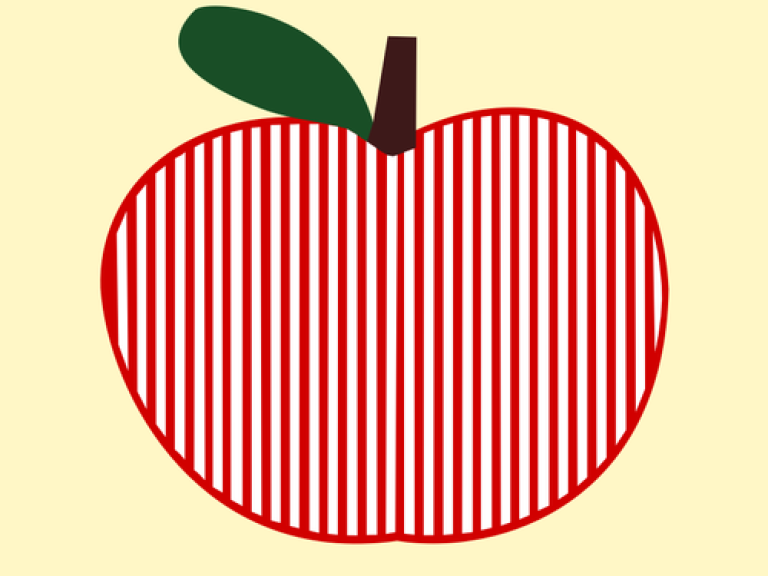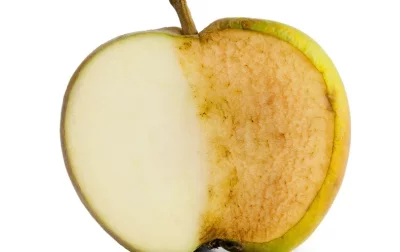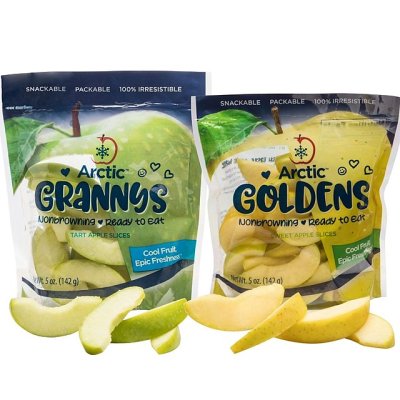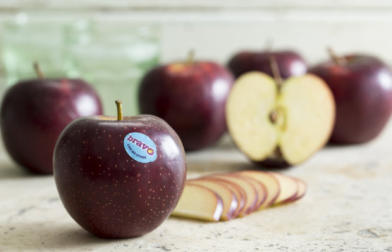Genetically modified apples

I recently created the German Wikipedia article for Arctic® Apples. Arctic® is a tradename for a group of patented apple varieties, which are the first genetically modified fruits approved for commercial production. This topic has been sitting in the back of my mind for quite a while. After discovering that German Wikipedia is lacking any information on this, I digitalised my thoughts. First on German Wikipedia, and now on my blog.
It is a well-known issue for any lover of fruit salads. After cutting apples, or many other fruits, the fruit flesh develops a brownish colour which is accompanied by a slight change in taste. This phenomenon is called enzymatic browning and happens when enzymes inside the apple come into contact with oxygen from the ambient air. An enzyme called polyphenol oxidase (PPO) turns the polyphenols, such as flavonoids, into catechins. These catechins have a yellow to brown pigmentation and are therefore responsible for the browning of the apples. Arctic® apples have been genetically modified, resulting in the polyphenol oxidase being significantly reduced, stopping the enzymatic browning.

Enzymatic browning on apple. Picture by Scientific American.
Any lover of fruit salads will also know the natural antidote of fruit browning, which is lemon juice. Lemon juice inhibits the enzyme PPO due to its low pH, but it also adds an acidic flavour to the apples. This might be not an issue for fruit salads, but if someone wants to preserve the natural flavour of apples, they would want to avoid lemon juice. Instead, antioxidants, such as calcium ascorbate, can reduce the activity of the enzyme PPO. But what is the purpose of this, outside of fruit salads?
The market for apple consumption is saturated. There is only a limited amount of apples that people will eat per year. But this market could be enhanced by offering apples as a convenience food. Cut into mouth-sized pieces and without a core, apples can be conveniently packaged and provided to potential new customers. There is some logical absurdity to these products. After all, they produce a lot of plastic waste for very minor reasons. But, these convenience products are in high demand. For many people, these are more appealing than the original products. In one study, convenient vegetable products led to a 19% increase of vegetable intake in students. For apple growers, a 19% increase in demand sounds like a dream come true. With this information, it is only logical to produce apple varieties that lack the natural PPO enzyme and to process apples without antioxidants (or at least with fewer antioxidants that are normally required). Packaging fruits and vegetables into sealed plastic still presents some challenges, such as microbial safety. There is a lot of published research that focuses on this problem:
- Quality of Fresh-cut Apple Slices as Affected by Low-dose Ionizing Radiation and Calcium Ascorbate Treatment
- Hot water treatment in combination with calcium ascorbate dips increases bioactive compounds and helps to maintain fresh-cut apple quality
- Control of Browning and Microbial Growth on Fresh-Cut Apples by Sequential Treatment of Sanitizers and Calcium Ascorbate
- Effects of calcium ascorbate treatments and storage atmosphere on antioxidant activity and quality of fresh-cut apple slices
- Effect of pH on the Survival of Listeria innocua in Calcium Ascorbate Solutions and on Quality of Fresh-Cut Apples

Arctic® Granny and Gold sold as convenient product. Picture by user Summerland1.
What sounds like a trivial problem when making a fruit salad, requires a lot of expertise when working on an industrial scale. Removing enzymatic browning at the root is therefore a massive improvement. But let us go back to the start. Where do the Arctic® Apples come from, how were they developed and where are they grown? Arctic® Apples were developed by the biotechnological company Okanagan Specialty Fruits. They used RNA-interference (RNAi) methods to turn down the expression of the genes responsible for the enzyme PPO. This enzyme is regulated by multiple genes, rather than just one. To reach sufficient reduction in activity, four genes were targeted by RNAi, namely MdPPO2, MdGPO3, MdAPO5 and MdpSR7. These genes were combined, together with a 35S promoter and a tNOS terminator, and introduced into conventional apple cultivars via Agrobacterium-mediated gene transfer (US Patent 8563805B2). However, these genes were introduced in sense direction. When these introduced genes are expressed, they produce RNA that is complementary to the original RNA of the PPO enzyme. The complementary RNA will bind and since RNA is supposed to be single-stranded only, they are deactivated. These genetical changes have been introduced into the well-known apple varieties: Golden Delicious, Granny Smith and Fuji. These varieties are also old enough that any pre-existing licenses or patents are most likely expired. Arctic® Golden and Arctic® Granny were first approved for commercial production in 2015 in the USA and 2017 in Canada. By 2020, Arctic® Apples were grown in the state of Washington on over 545 ha and produced a yield of about 5900 t. By comparison, the overall apple yield across the USA was over 5,000,000 t in 2018.
The introduced genetical modification, results in PPO enzyme activity that is less than 10% of the original genotype. I already mentioned that this makes these apples an ideal candidate for convenience products. According to the developers however, they were targeting a much greater goal: reducing fruit waste. Their website promotes: “Good-bye half eaten apples”. It is true, about 40% of food waste happens at the household-level. For some people, browning apples might be a part of this. However, whether the reduction of food waste due to reduced enzymatic browning of apples outweighs the environmental costs of increased processing and packaging material, remains open to research. What about another claim they make on their website? “An apple’s browning reaction typically “burns up” healthful antioxidants, and Arctic® apples avoid this browning reaction.” As mentioned before, PPO turns polyphenols into catechins. However, these are associated with just as many positive health benefits as their non-oxidised version. I am also a bit sceptical about this statement.
Although I am not super convinced by the producer’s apparent goals, I am positive about this kind of genetical modification, meaning the use of RNAi to de-activate natural genes or the use of cis-genetic approaches to introduce genes that are already present in wild types. In the case of fruit tree breeding, significant time savings can be achieved this way. Due to the late onset of fruits, the conventional breeding of new apple varieties takes around 30-50 years. Using GMO approaches significantly reduces this time span. This is of particular importance if we consider resistance breeding against common pathogens. Pathogens often overcome conventional resistances within a few seasons. Hence the development of stacked resistance breeding, where the introduction of multiple resistance genes makes it exponentially harder for pathogens to adopt. This, however, requires basically the use of GMO approaches or, with apples, an early flowering approach. Finally, another advantage is that with Arctic® apples, already well-established apple varieties were modified. This means that apple producers are already aware of the growth and harvest requirements.

Apple variety Bravo™. Picture by Fruitwest.
I enjoy eating apples and I go through around five apples per week. The bigger, the better. It is very rare that apples will start enzymatic browning in my household, because they get eaten as a whole. Rather than silencing the PPO enzyme, I would have preferred the introduction of resistance genes, which could decrease the use of agrochemicals. Personally, I would also prefer the introduction of some new apple varieties with more exciting flavours. After all, most of our current supermarket apples share a genome with Golden Delicious, a common selection partner due to its favourable growth and yield properties. But I say this as an apple enthusiast, rather than the average apple consumer. Needless to say, I look forward to any new apple developments, either done with conventional breeding methods or with biotechnological ones. One new apple variety I recently purchased at a local Australian supermarket is called Bravo™. It is 100% GMO-free, so the time between breeding and supermarket launch also took about 30 years. Well worth the wait, because this is my new favourite apple variety.